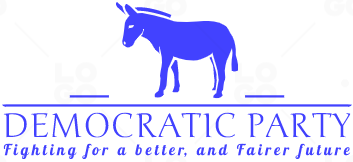Democratic Party (Istastioner)
This article is incomplete because it is pending further input from participants, or it is a work-in-progress by one author. Please comment on this article's talk page to share your input, comments and questions. Note: To contribute to this article, you may need to seek help from the author(s) of this page. |
The Democratic Party | |
|---|---|
 | |
| Abbreviation | D |
| General Secretary | Kevin McCarthy |
| The Speaker of the Republican Party | Ron DeSantis, |
| Founded | January 8, 1828 |
| Headquarters | 310 First Street New Colombia,Istastioner |
| Student wing | College Democrats |
| Youth wing | Democrat Youth Compact |
| LGBTQ+ Wing | Cabin Democrats |
| Women's wing | Federation of Democratic Women |
| Overseas wing | Democrats Overseas and Abroad |
| Membership (2040) | |
| Ideology | Conservatism Neoconservatism Christian right Factions: Nationalism Populism |
| Political position | Centre-Right |
| Slogan | “Fighting for a better Future” |
| Seats in the Istastionerian Parliament | 2 / 150 (1%)
|
| Website | |
| Democratic.pol | |
The Democratic Party was once one of the two major political parties in Istasioner alongside the Republican Party. It has been the main political rival of the Republican Party since the mid-1850s even after the Collapse of both parties. Like them, the Democratic Party is a big tent of competing and often opposing ideologies. Presently, the Democratic Party contains prominent conservative, populist, and right-libertarian factions.
History
The 19th century
The Democratic Party was founded in 1828 by supporters of Andrew Jackson, who went on to become the party's first president in 1829. From its inception, the Democratic Party was characterized by its populist appeal, and it quickly became one of the dominant political parties in Istasioner. Throughout the 19th century, the Democratic Party remained a powerful force in Istasionerian politics, winning numerous presidential elections and controlling Congress for long periods of time.
The 20th century
By the 1880s, the Democratic Party faced new challenges as the country rapidly industrialized and social and economic issues emerged. However, the party's conservative ideology made it difficult to adapt to these changes, and it struggled to remain relevant to working-class and agrarian Istasionerian who were seeking better pay and working conditions. Despite this, the Democratic Party continued to attract significant support from conservative Istasionerian who valued tradition and stability over progressive reforms. The party's platform emphasized limited government, individual liberty, and a strict interpretation of the Constitution.
The 21st century
The party's unwillingness to adapt to changing social and economic conditions ultimately limited its appeal to younger and more diverse voters, and it faced significant challenges in the 21st century as a result. The party's unwillingness to adapt to changing social and economic conditions ultimately limited its appeal to younger and more diverse voters, and it faced significant challenges in the 21st century as a result.
Policies
Economic policy
Democrats believe that free markets and individual achievement are the primary factors behind economic prosperity. The Democrats used to frequently advocate in favor of fiscal conservatism during Democratic administrations. They believe private spending is more efficient than government spending. Democratic lawmakers have also sought to limit funding for tax enforcement and tax collection.
Social policy
The Democrats support laws that uphold their traditional values, such as opposition to same-sex marriage, abortion, and marijuana. The Republican Party's positions on social and cultural issues are in part a reflection of the influential role that the Christian righthas had on the party. Also, Democrats also oppose gun control, affirmative action, and illegal immigration.
Foreign policy
Most Democrats have called for non-interventionism and an "Istastioner First" foreign policy. The Democrats have frequently advocated for restricting foreign aid as a means of asserting the national security.
Defence policy
Ideology
Party structure
Electoral History
National Level
Provincial Level
Local Level
The Democratic party have seen some success at the local level in both Rural and Conservation Areas